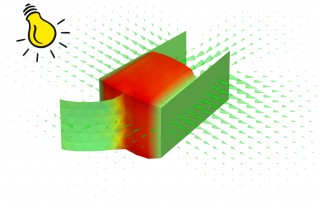By Kalwinder KaurAug 8 2012
Based on complex computational models, a team of researchers at the Georgia Institute of Technology will engineer swimming micro-robots that are capable of responding to stimuli like light. These micro-robots can also be designed for carrying cargo.
 Illustration shows the rigid propulsive flaps on each side of the micro-swimmer, while the steering flap on the front is being deformed by a light source. The green cones represent velocity vectors through the middle of the micro-swimmer.
Illustration shows the rigid propulsive flaps on each side of the micro-swimmer, while the steering flap on the front is being deformed by a light source. The green cones represent velocity vectors through the middle of the micro-swimmer.
Based on volume changes in hydrogels, these micro-robots move using tiny flaps. They can therefore be employed as micro-construction robots working in swarms, for lab-on-a-chip microfluidic systems, and drug delivery.
The simple micro-swimmers were reported on July 23 dated online advance edition of the journal Soft Matter, released by the U.K.-based Royal Society of Chemistry.
Alexeev and his research team including Benjamin Bingham and Hassan Masoud designed this simple swimmer with a 10 µm long responsive gel body having two parallel propulsive flaps. Specific stimuli-sensitive steering flap is placed anterior to the swimmer.
Various reactions and oscillations will create contractions and expansions to the responsive gel body, periodically. This property along with chemical swelling and de-swelling of the material will allow the rigid propulsive flaps equipped to the micro-swimmer to have a beating motion, thereby propelling the micro-swimmer.
A flexible steering flap attached to the front leverages the trajectory of the micro-swimmer. The hydrogels with cylindrical alteration of volume will act as “chemical engines” enabling the movement of flaps integrated to the device.
Based on the computational fluid modeling, the researchers learnt various parameters in oscillation rates, materials, and flexibility. The research team will ultimately construct the micro-swimmers.
The researchers foresee a swarm of micro-swimmers that carry cargo via microfluidic chips or other devices.
Source: http://gtresearchnews.gatech.edu/
Disclaimer: The views expressed here are those of the author expressed in their private capacity and do not necessarily represent the views of AZoM.com Limited T/A AZoNetwork the owner and operator of this website. This disclaimer forms part of the Terms and conditions of use of this website.